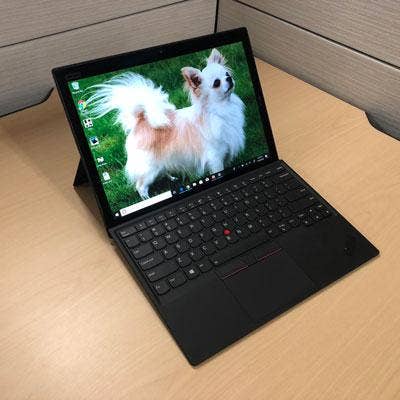Review: Lenovo's Revamped ThinkPad X1 Tablet Is (Mostly) An Upgrade

Lenovo has overhauled its business-oriented 2-in-1 tablet, the ThinkPad X1 Tablet, with its third generation release this year. And fans of the series should be pleased with the outcome—for the most part. We're not completely sure that the tablet is different enough to prompt a switchover from a laptop or a Surface Pro, however. A few key trade-offs stand in the way.
First, though, let's consider the best part with the third-gen X1 Tablet: the display. The tablet goes for 3K (3,000 x 2,000) resolution, up from 2,160 x 1,440 previously, and it's a stunner. The screen is ultra crisp and a joy to look throughout a day of work. It's also super bright—probably even too bright for most indoor use at 400 nits.
[Related: Head-To-Head: Lenovo ThinkPad X1 Carbon Vs. Microsoft Surface Pro]
The display is also larger this time around, at 13 inches, versus the 12-inch display in the previous model. That puts it on the larger end of the spectrum for tablet displays—the Surface Pro measures 12.3 inches—but laptop users might be more enticed by this form factor since it's closer to the typical size of a notebook screen.
Performance is another big upgrade with the new version of the X1 Tablet. While the previous model had used Intel's low-power Y series chips, the third-gen model goes for Intel's speedier U series. Our model used a Core i5 processor and we found the performance to be excellent—everything was flying with our web and PowerPoint usage, and having multiple apps and windows open didn't drag things down in the least.
One distinguishing element is how durable the X1 Tablet is compared to other 2-in-1 tablets on the market. The device integrates Gorilla Glass on the display and meets the military durability standards that are typical of other ThinkPads. The tablet's metal kickstand and the accompanying hard plastic keyboard are definitely more solid than others we've tried, as well.
Speaking of the keyboard, Lenovo has tweaked the design to make the keyboard even stiffer (even though we thought the previous version already rated high in this regard). Overall, we found the typing experience on the X1 Tablet keyboard to be good—not quite up to the level of most laptops, but pretty close (it's a better keyboard than the MacBook Pro, for one thing). The key travel is fairly deep, at 1.5mm, and the keys themselves are comfortable and not overly clacky.
Battery life is a central consideration for most users of 2-in-1 tablets, since business travel is a main use case for these devices. Unfortunately, the latest ThinkPad X1 Tablet doesn't see much improvement there even though it comes with a larger battery. The tablet managed five hours of battery life—the same as the second-generation model—in our tryout at 75 brightness and with heavy usage.
The higher-powered processor may be one reason. Another is that, as we mentioned, the screen on the X1 Tablet is extremely bright. Setting the brightness to 50 percent got us another hour of battery life, and we felt this was still bright enough for using in the office.
Maybe a bigger concern is that the new X1 Tablet design adds some heft, which detracts somewhat from the selling point as an on-the-go solution. While the previous model weighed 2.4 pounds, the larger display and battery of the new version bring it up to 2.8 pounds. The makes the device a noticeable amount heavier than the Surface Pro (2.37 pounds) and even Lenovo's own ThinkPad X1 Carbon laptop (2.5 pounds). As we said: tradeoffs.
Another major change with the X1 Tablet is there's no longer an option to attach external modules--including one module that added battery life and another that turned the tablet into a projector. The module concept was a main differentiator with the previous two generations of the X1 Tablet. And some Lenovo-oriented solution providers we spoke with did like that aspect of the device, as it made the tablet stand out from the pack, but apparently there wasn't enough interest. (R.I.P.)
Digital pen users may or may not like Lenovo's answer for the perennial question of how to store the stylus. A removable pen holder is now placed on the right side of the tablet, which works well while you're using it, but inevitably the pen falls out if you try to store it in the holder with your bag. The stylus itself, the ThinkPad Pen Pro, worked well in our tryout with little latency.
In terms of ports, the selection is pretty sparse. There are two USB-C/Thunderbolt 3 ports provided, but you'll need a dongle to get USB-A or HDMI. That's in contrast to the Surface Pro, which opts for USB-A over USB-C. The X1 Tablet also houses a MicroSD card reader and Nano Sim slot.
Security features that should appeal to many businesses include a fingerprint reader, Windows Hello facial recognition, FIDO (Fast Identity Online) authentication capabilities and a Trusted Platform Module chip for encryption.
Additionally, the third-gen X1 Tablet adds an option for LTE connectivity, for situations with untrusted (or lacking) WiFi.
All in all, Lenovo's third-gen ThinkPad X1 Tablet has a lot going for it. The device won't come cheap, with a price of $1,296 for eighth-gen Core i5, 8 GB of RAM and Windows 10 Pro. But that's still less than the cost of many laptops, and seems competitive for a device that gets so much of the key stuff right with its terrific display, performance and keyboard.